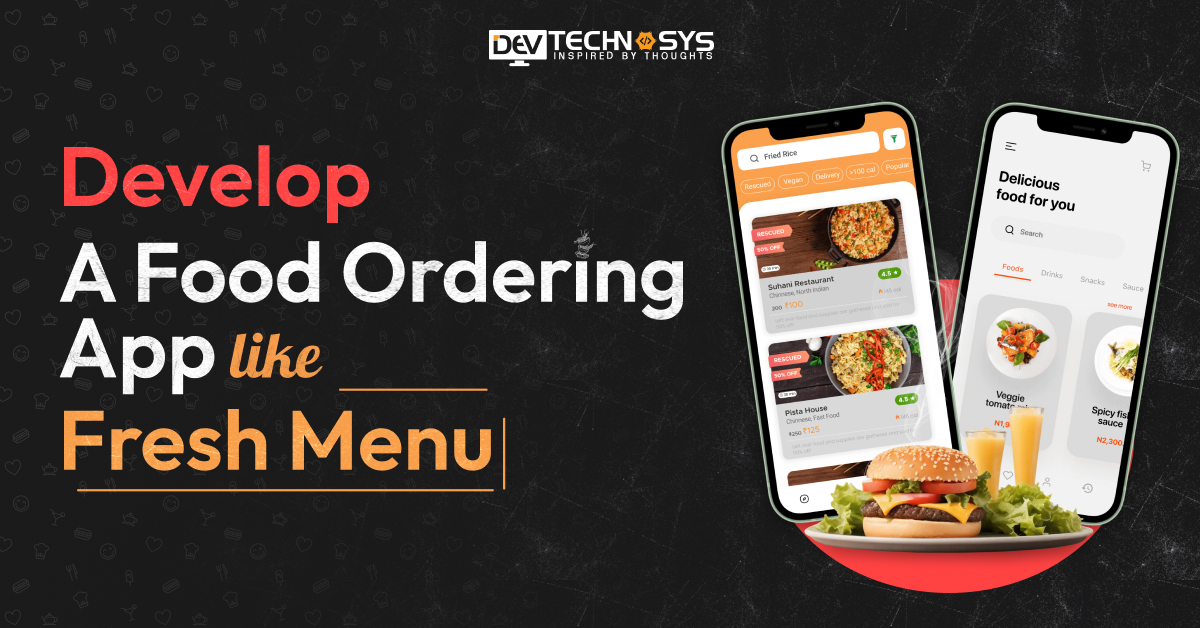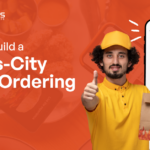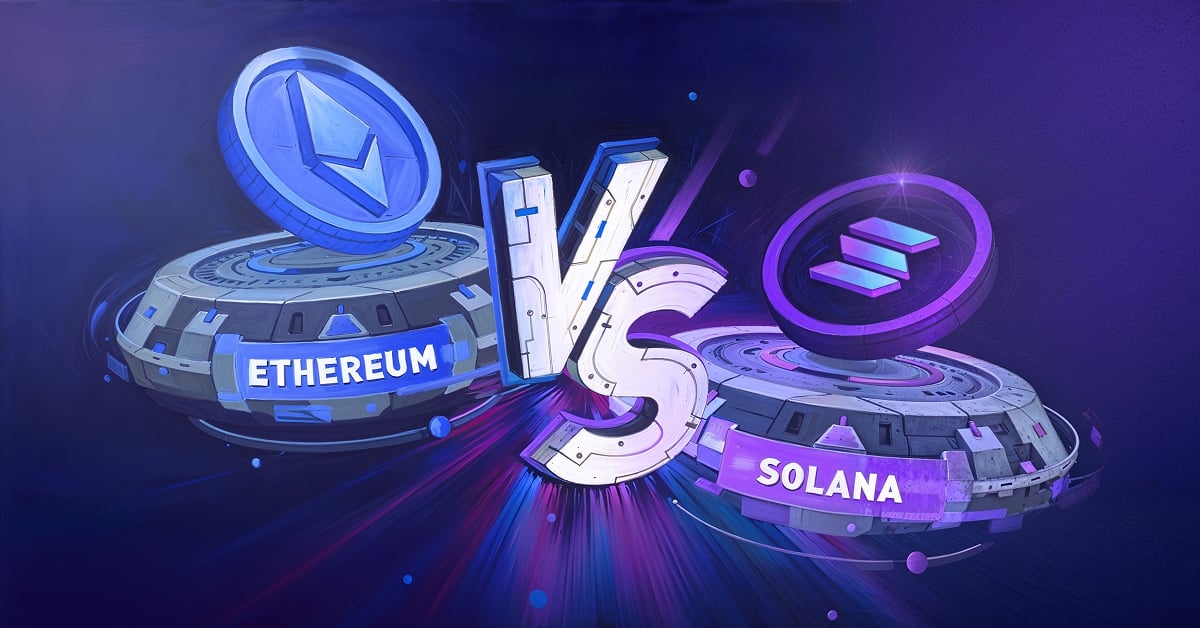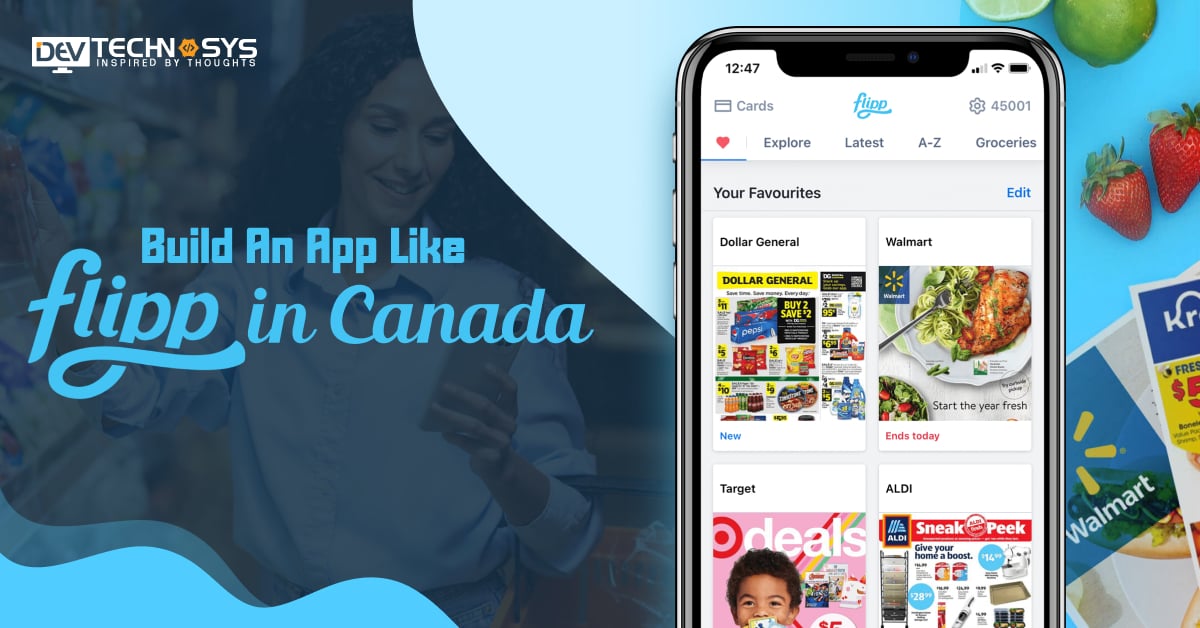“Tasty bites, one tap away”
It is very common for every food restaurant owner or startup to want to build a food ordering or delivery app to expand their business and increase overall sales. Some of the businesses have no idea how they can develop a food ordering app. Just read the blog till the last.
Have you ever heard about a food ordering app like Fresh Menu? If no.
Then it’s the right time to reveal their functionalities and the growing demand for this app. It offers professionally prepared meals with fresh, high-quality ingredients by the chef. That’s the reason why people love this app and enjoy the fresh food orders.
According to global reports, the food ordering applications market was valued at approximately $1.39 trillion in 2025 and is expected to reach around $2.02 trillion by the end of 2030.
The above figure shows why it is the best opportunity to invest in food ordering app development.
In this blog, we will take you on a long ride on how to develop a food ordering app like Fresh Menu and other related information.
What is Fresh Menu?
FreshMenu is an online food delivery business that provides chef-crafted meals made with fresh ingredients. Founded in India, it serves a changing menu of different cuisines, including salads, main meals, desserts, and drinks. The meals are prepared in cloud kitchens and delivered straight to clients, assuring both convenience and quality. A food ordering app like Fresh Menu is dedicated to serving nutritious, delectable cuisine and providing a flawless digital ordering experience.
- Daily Rotating Menu
- Multi-Cuisine Options
- Fast Delivery
Market Analysis of Global Food Ordering Applications
- The market for food ordering apps was estimated to be worth $1.39 trillion in 2025 and is projected to grow to $2.02 trillion by the end of 2030.
- It is anticipated that revenue would rise at a 64% annual rate (CAGR 2025–2030).
- In contrast, China will earn the majority of worldwide income (US$499.14 billion in 2025).
- By 2030, there are projected to be 5 billion consumers in the meal delivery sector.
- By 2025, the market for meal delivery would have a 2% user penetration rate.
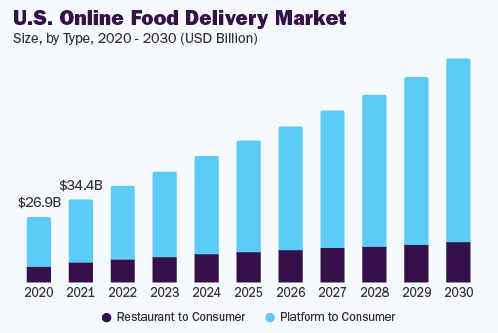
10 Popular Food Ordering Apps Like Fresh Menu
Discover 10 popular food delivery apps like FreshMenu that deliver delicious meals to your doorstep, offering variety, convenience, and great deals for every taste.
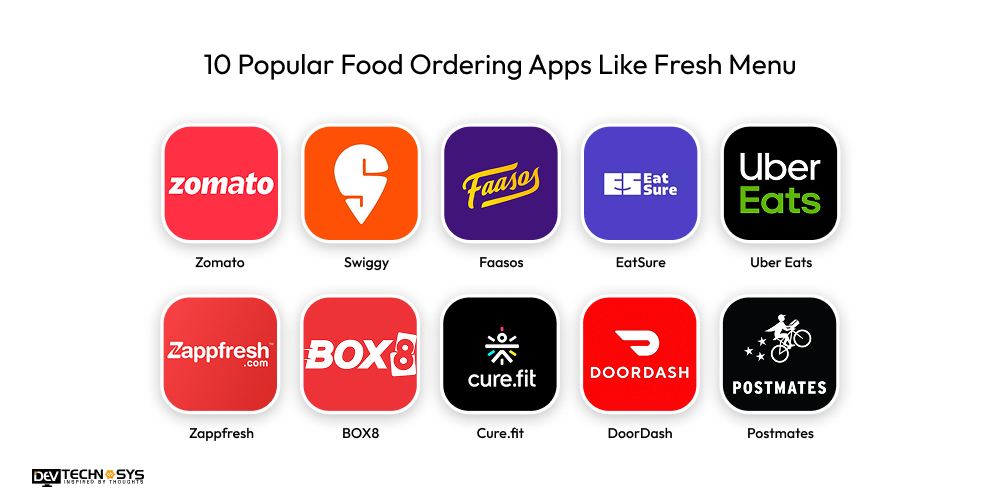
| App Name | Downloads | Stores Ratings | Launch Year | Platform Availability |
| Zomato | 100M+ | 4.2 | 2010 | Android, iOS |
| Swiggy | 100M+ | 4.3 | 2014 | Android, iOS |
| Faasos | 10M+ | 4.2 | 2011 | Android, iOS |
| EatSure | 1M+ | 4.3 | 2014 | Android, iOS |
| Uber Eats | 10M+ | 4.2 | 2017 | Android, iOS |
| Zappfresh | 1M+ | 4.3 | 2015 | Android, iOS |
| BOX8 | 1M+ | 4.3 | 2014 | Android, iOS |
| Cure.fit | 10M+ | 4.8 | 2016 | Android, iOS |
| DoorDash | 50M+ | 4.8 | 2013 | Android, iOS |
| Postmates | 10M+ | 4.7 | 2011 | Android, iOS |
Why Businesses Want to Invest in Food Ordering App Development?
Investing in cross-city food ordering app development allows businesses to tap into a growing digital economy, gain competitive advantage, and meet modern consumer expectations—all while maximizing profitability and brand reach.
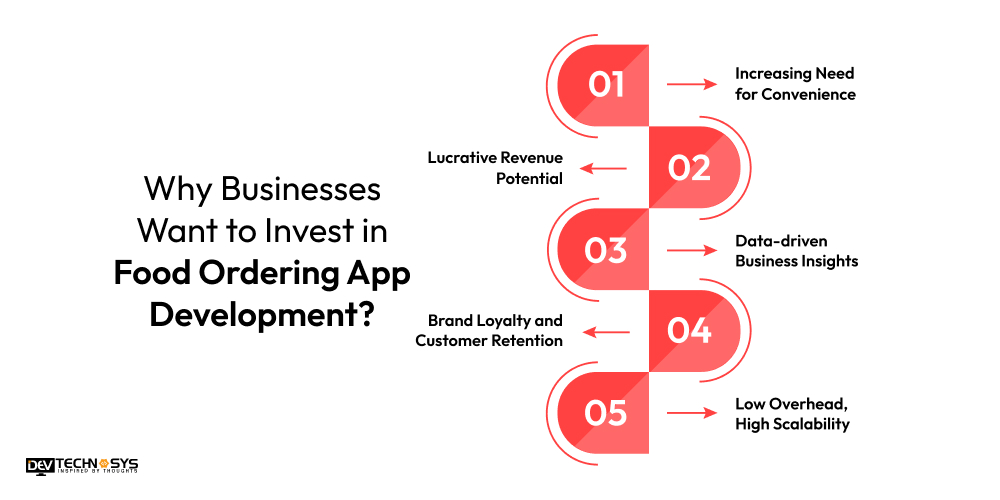
1. Increasing Need for Convenience
Customers nowadays enjoy buying food online because of the ease it provides. Users with busy schedules and a digital-first attitude want rapid, hassle-free answers. Food ordering applications match these expectations by allowing customers to explore menus, make orders, and pay with a few touches. This increased reliance generates a consistent demand that corporations wish to profit on.
2. Lucrative Revenue Potential
Food delivery app like Foodhub is a multibillion-dollar sector that is expected to expand dramatically in the future years. Businesses can make revenue through a variety of avenues, including delivery fees, surge pricing, in-app advertising, subscription programs, and commissions from partner restaurants. The scalability of app-based platforms makes them an appealing long-term investment with great return potential.
3. Data-driven Business Insights
Food ordering applications acquire useful information about users’ behavior, interests, and trends. Businesses may use this information to provide more tailored experiences, streamline delivery operations, and increase customer happiness. Analytics insights may also aid with strategic decision-making, allowing for better marketing campaigns and menu upgrades.
4. Brand Loyalty and Customer Retention
Food delivery apps like Seamless strengthen client connections by offering features such as reward programs, tailored discounts, order monitoring, and customer ratings. Push alerts and loyalty prizes help to retain consumers, while user-friendly interfaces drive repeat purchases. This degree of participation promotes long-term brand loyalty, which is essential for long-term success.
5. Low Overhead, High Scalability
Food order apps require less physical infrastructure than conventional brick-and-mortar businesses do. Cloud kitchens and collaborations with third-party providers lower overhead expenses. Fresh Menu clone apps may begin locally and grow internationally, allowing organizations to increase operations with no extra cost.
How AI can Improve the Food Ordering Apps Operations?
- AI analyzes user preferences to suggest dishes, increasing customer satisfaction and boosting order frequency effectively.
- AI calculates the fastest delivery paths in real-time, reducing delivery time and enhancing the overall customer experience efficiently.
- AI predicts peak order times and popular items, helping restaurants manage inventory and reduce food waste accurately.
- AI-powered chatbots handle queries instantly, improving response times and providing 24/7 assistance to users seamlessly.
- AI detects unusual payment patterns, preventing fraud and ensuring secure transactions for customers and businesses reliably.
7 Robust Steps to Develop a Food Ordering App Like Fresh Menu
Create a seamless food ordering app like FreshMenu with features like intuitive UI, real-time tracking, diverse menus, secure payments, and personalized recommendations—delivering convenience and delicious meals straight to customers’ doors while boosting your business growth and customer loyalty. So, let’s take a look at the food delivery app development process:
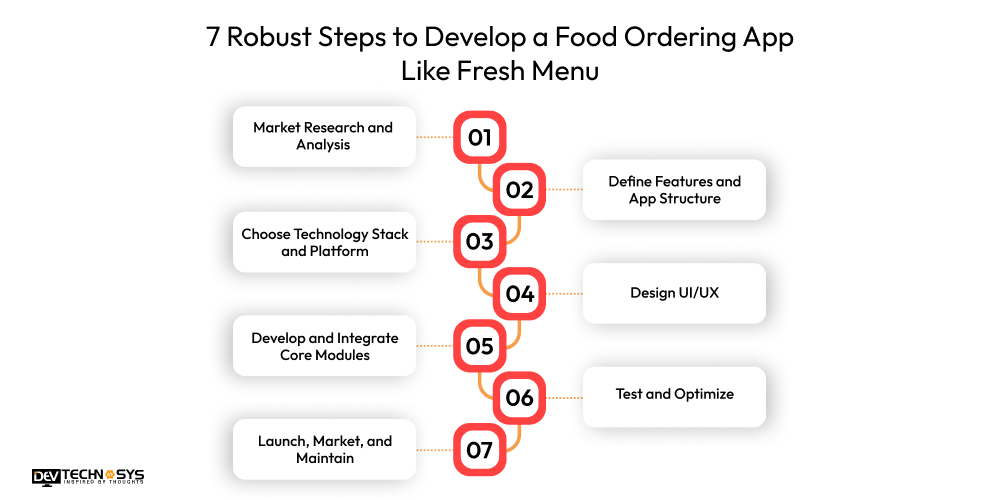
1. Market Research and Analysis
Study your target audience, competitors, and market trends to identify customer needs and gaps. Hire dedicated developers to analyze successful apps like FreshMenu to understand popular features, pricing, and user preferences. This foundation guides your app’s design and unique value proposition.
| What are your competitors offering? |
| Who is your target audience? |
| What gaps exist in the current market? |
2. Define Features and App Structure
In the second stage to create an app like Fresh Menu, list essential features such as user registration, menu browsing, order placement, payment integration, delivery tracking, and reviews. Plan app architecture for smooth navigation and scalability. Prioritize features that enhance user experience while aligning with your business goals.
| What core features are essential for the app? |
| Should the app support multiple cuisines? |
| What payment methods should be integrated? |
3. Choose Technology Stack and Platform
Select the right technology stack (e.g., React Native, Flutter) for cross-platform compatibility. Decide whether to launch on Android, iOS, or both. Hire mobile app developers to consider backend services, cloud infrastructure, and APIs for payments, notifications, and GPS tracking to ensure reliability and performance.
| Which platforms should the app support—Android, iOS, or both? |
| Which programming languages fit our project needs? |
| What backend technologies will ensure scalability? |
4. Design UI/UX
Let’s connect to the fourth stage to build an app like Fresh Menu, create intuitive and visually appealing designs focusing on ease of use. Design wireframes, prototypes, and final UI with smooth navigation, clear CTAs, and attractive visuals. Optimize for mobile responsiveness, fast loading, and accessibility to maximize user engagement.
| Which platforms should the app support—Android, iOS, or both? |
| Which programming languages fit our project needs? |
| What backend technologies will ensure scalability? |
5. Develop and Integrate Core Modules
Begin app development by coding the frontend and backend modules. Hire a professional mobile app development company to integrate third-party APIs for payments, maps, and notifications. Implement secure login, order processing, inventory management, and real-time order tracking. Regularly test modules for bugs and usability.
| How will the user authentication module be developed? |
| What logic will manage the menu and item details? |
| What payment gateways should be integrated? |
6. Test and Optimize
In the sixth stage to develop an app like Fresh Menu, conduct comprehensive testing—functional, usability, performance, and security testing. Gather feedback from beta users to identify pain points and bugs. Optimize app speed, fix errors, and enhance features based on testing results to ensure a seamless user experience.
| What types of testing will be conducted? |
| What performance benchmarks should the app meet? |
| What feedback mechanisms will be used during beta testing? |
7. Launch, Market, and Maintain
Move to the last food ordering mobile app development process, release the app on chosen platforms. Use digital marketing, social media, and influencer collaborations to attract users. Monitor app performance, user reviews, and analytics. Continuously update the app with new features, security patches, and improvements to retain and grow your user base.
| Which app stores will the app be published on? |
| What promotional campaigns will attract initial users? |
| How will app performance be monitored post-launch? |
10 Basic and Advanced Features that Must be Integrated in a Food Ordering App
These features ensure a smooth, engaging, and trustworthy experience, helping your food ordering app stand out in a competitive market.
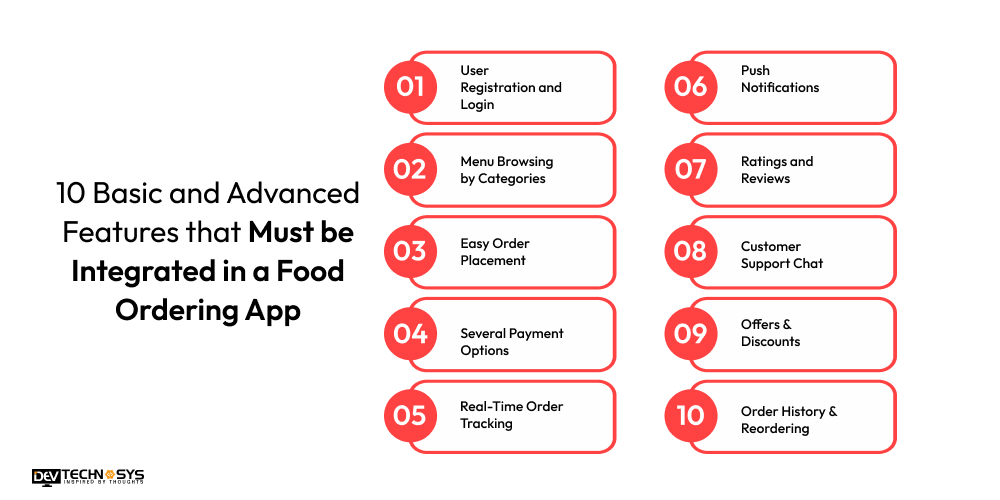
1. User Registration and Login
An app like Blinkit allows users to establish accounts using email, phone number, or social network. This enables more personalized experiences and efficient order tracking.
2. Menu Browsing by Categories
Fresh Menu alternatives organize the menu into distinct sections, complete with photographs, descriptions, and pricing.
3. Easy Order Placement
Make the ordering process simple by providing a straightforward interface that allows customers to add things to their basket, customize orders, and evaluate them before checking out.
4. Several Payment Options
If you create a mobile app like Fresh Menu, it support a variety of payment options, including credit/debit cards, wallets, UPI, net banking, and cash on delivery.
5. Real-Time Order Tracking
Show live updates on order status—from preparation to delivery—to keep consumers informed and confident about their orders.
6. Push Notifications
Send out timely notifications for purchase confirmation, delivery updates, offers, and reminders to keep consumers interested and informed.
7. Ratings and Reviews
An app like Swiggy allows people to review food and delivery services, generating input that improves quality and fosters confidence among new customers.
8. Customer Support Chat
Fresh Menu alternatives Integrate chat or chatbot functionality to provide rapid inquiry response, increasing customer happiness and retention.
9. Offers & Discounts
Display continuous deals, referral bonuses, and loyalty benefits to stimulate repeat purchases and increase sales.
10. Order History & Reordering
Fresh Menu clone apps allow consumers to examine previous orders and reorder favorite meals with a single swipe, increasing convenience and speed.
What is the Cost to Develop a Food Ordering App Like Fresh Menu?
The cost to develop a food ordering app like FreshMenu typically ranges from $8,000 to $25,000, depending on complexity, features, and platform choice (iOS, Android, or both). Factors influencing cost include UI/UX design, backend development, third-party integrations (payment gateways, maps), and testing.
Custom features like real-time tracking and AI recommendations increase food delivery app development cost. Ongoing maintenance and marketing also add to the budget. Exact costs vary based on development team rates and project scope.
| Food Ordering App Development | Estimated Cost | Time Frame |
| Basic App Development | $8000 – $12000 | 2 to 6 Months |
| Mid-Complex App Development | $14000 – $19000 | 6 to 8 Months |
| High-Complex App Development | $25000+ | 9+ Months |
5 Key Factors that Affect the Food Ordering App Development Cost
Key factors affecting food ordering app development costs include feature complexity, platform choice (iOS, Android, or both), design quality, third-party integrations like payment gateways and maps, development team expertise, location, and ongoing maintenance.
Custom functionalities and scalability requirements also significantly influence the overall mobile app development cost.
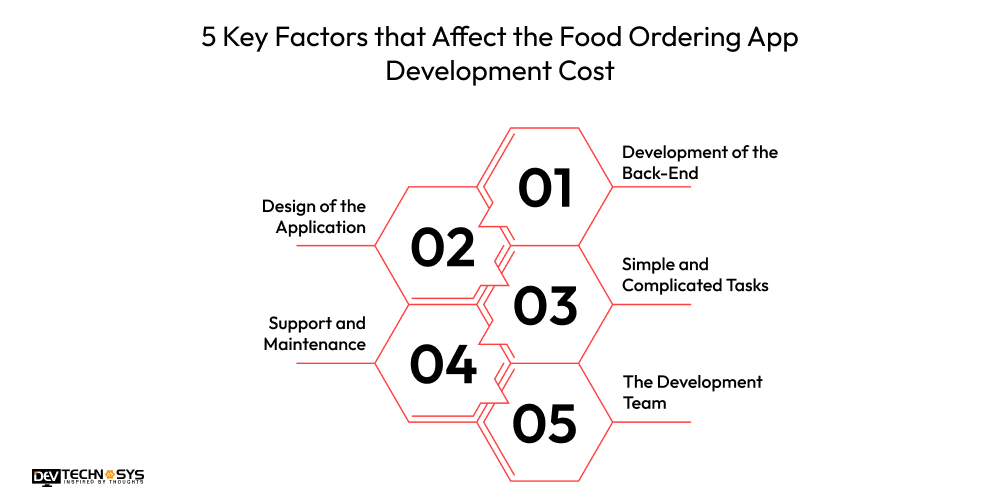
1. Development of the Back-End
User authentication, database administration, server logic, and API integration are all handled by the back-end. More time and resources are needed for complex back-end architecture, which raises Fresh Menu app development cost. An essential and frequently expensive aspect of app development is a scalable, secure back-end, which guarantees seamless order processing and real-time changes.
| Backend Development | Cost Estimation |
| Simple Backend Process | $10,000 – $16,000 |
| Advanced Backend Process | $20,000 – $25,000 |
2. Design of the Application
Although it requires more development hours and trained designers, an intuitive, visually appealing UI/UX design increases user engagement. The total restaurant mobile app development cost is affected by the additional work needed for responsive layouts, custom animations, and smooth navigation.
Higher costs in this area are justified by the improved customer happiness and company reputation that comes from investing in high-quality design.
| Design Quality | Cost Estimation |
| Basic Design | $8,000 – $12,000 |
| Complex Design | $15,000 – $22,000 |
3. Simple and Complicated Tasks
While more complex features like AI suggestions, real-time tracking, and dynamic pricing demand more development time and experience, basic functions like menu browsing and order placing are less expensive.
Although adding complicated modules delivers greater user experience and distinctiveness, it also dramatically increases Fresh Menu app development cost.
| Features | Cost Estimation |
| Core Features(Browse & Search Menu and Order Customization) | $8,000 – $10,000 |
| Advanced Features(Order History & Reorder and Favorites & Wishlist) | $13,000 – $18,000 |
4. Support and Maintenance
The food delivery app maintenance services include, bug patches, updates, and post-launch support. The app remains competitive with frequent updates based on user input and technological advancements. Long-term app stability and performance depend on dedicated maintenance teams or contracts, which raise the expense.
| Maintenance Phase | Cost Estimation |
| Simple Maintenance Phase | $2,000 – $4,000/year |
| Complex Maintenance Phase | $7,000 – $9,000/year |
5. The Development Team
The team’s size, location, and level of experience all affect the price. Although it could cost more to hire local specialists than offshore teams, doing so can improve communication. The cost contributions of full-stack developers, designers, and testers vary. Effective, knowledgeable teams may produce high-quality work while saving money and time.
| Developer’s Experience Level | Cost Estimation |
| Entry-Level Developer | $15 – $18/ Per Hour |
| Mid-Level Developer | $18 – $22/ Per Hour |
| Senior-Level Developer | $25+ / Per Hour |
How to Generate Revenue From a Food Ordering App Like Fresh Menu?
Combining these monetization strategies allows similar app like Fresh Menu to diversify revenue streams, improve profitability, and reinvest in platform enhancements. Balancing customer satisfaction and partner incentives is key to sustainable growth and market leadership.
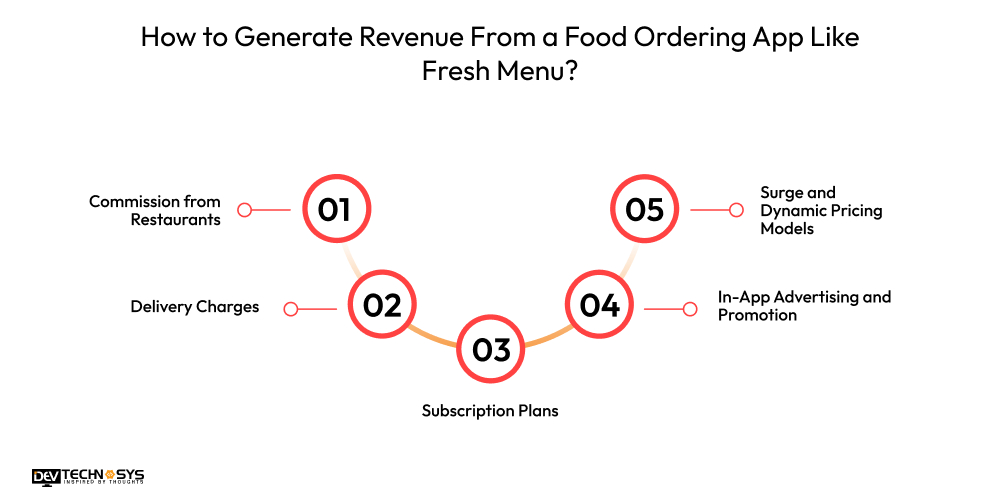
1. Commission from Restaurants
One of the key business streams for meal ordering apps is charging a fee to partner restaurants for each order. This amount fluctuates but normally ranges between 10% and 30%. As apps like Beyond Menu become popular, restaurants profit from increasing sales, making commissions a consistent revenue stream for the platform.
2. Delivery Charges
Order food apps might charge clients a delivery fee for each order to cover logistics and transportation costs. This price may be set or variable, based on the distance, order size, or demand. Offering premium delivery choices, such as express delivery, at a greater cost, increases income.
3. Subscription Plans
An app like DoorDash introducing subscription solutions for consumers or restaurants might help generate recurring income. Subscriptions may provide clients with privileges such as free delivery, special discounts, or priority service. Restaurant membership packages may offer better listing tools, marketing specials, or analytics data.
4. In-App Advertising and Promotion
Fresh Menu clone apps can sell advertising space to restaurants or companies to promote special deals, new dishes, or seasonal menus. Sponsored listings and banner advertisements increase visibility for partners and earn revenue. Targeted marketing based on user preferences improves ad performance.
5. Surge and Dynamic Pricing Models
The app like SkipTheDishes can incorporate surge pricing during peak hours or high-demand times, which increases delivery or service rates. Dynamic pricing modifies costs based on parameters such as order volume, time, and location, allowing businesses to optimize earnings while retaining clients.
Conclusion
In conclusion, develop a food ordering app like Fresh Menu needs careful planning, good design, and smart features to make it easy for users. Choosing the right technology and testing the app well are very important. A reliable food delivery app development company can help build an app that works smoothly and looks great. After launching, it’s important to keep updating and fixing issues so customers stay happy. With the right team and effort, your app can become popular and successful in the busy food delivery market.
Frequently Asked Questions
Q1. How Much Does It Cost To Develop a Food Ordering App Like Fresh Menu?
The cost to build a food ordering app like Fresh Menu ranges from $8,000 to $25,000, depending on the features, design complexity, platform choice, development team, and the integration of advanced technologies such as real-time tracking and payment gateways.
Q2. How Much Time Does It Take to Create a Food Ordering App Like Fresh Menu?
To create a food ordering app like Fresh Menu, it usually takes 3 to 6 months, depending on features, design complexity, development team efficiency, and thorough testing for a smooth user experience.
Q3. Which Technologies Are Used to Make a Food Ordering App Like Fresh Menu?
Technologies used to make a food ordering app like Fresh Menu include React Native or Flutter for the frontend, Node.js or Django for the backend, Firebase or AWS for the cloud, and Stripe or PayPal for payments integration.
Q4. What Are the First Steps to Develop a Food Ordering App Like Fresh Menu?
The first steps include conducting market research, identifying your target audience, defining key features, choosing a development approach, setting a budget, and partnering with a skilled Fresh Menu app development company.
Q5. How to Handle Delivery Logistics in the App?
Handle delivery logistics by integrating GPS for real-time tracking, assigning delivery personnel automatically, optimizing routes using map APIs, and updating users with live status from order confirmation to final delivery.
